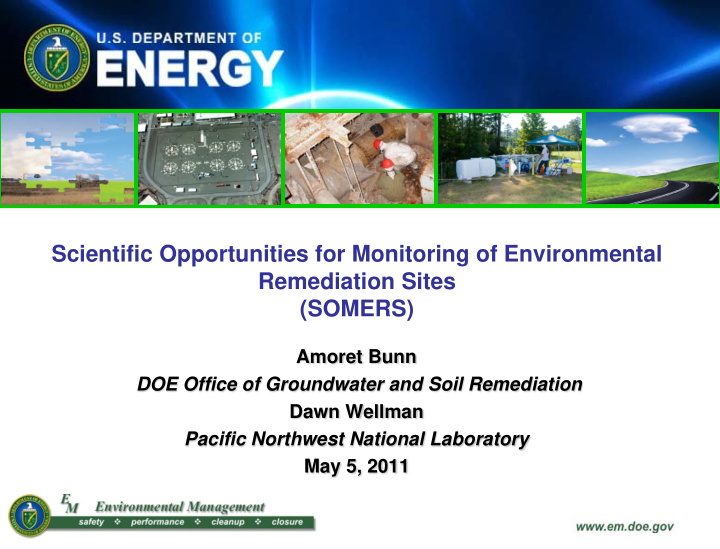



Scientific Opportunities for Monitoring of Environmental Remediation Sites (SOMERS) Amoret Bunn DOE Office of Groundwater and Soil Remediation Dawn Wellman Pacific Northwest National Laboratory May 5, 2011
Perspective on Monitoring Needs within DOE’s Office of Environmental Management From presentation by Dr. Ines Triay, Assistant Secretary, DOE Office of Environmental Management, to 2011 Congressional Nuclear Cleanup Caucus, February 17, 2011, Environmental Management FY 2012 Budget 2 Overview
Monitoring Challenge Monitoring represents largest legacy cost to the Department of Energy Effect of a remedial action with respect to risk to human health and the environment is determined from information gathered through monitoring activities Phased approach to cover changing goals as sites transition from remediation into long-term surveillance and maintenance Current monitoring approaches use point-source based groundwater monitoring well sampling and laboratory analyses –Inefficient, costly, labor-intensive 3
Progress to Date Previous efforts tackled a specific set of questions or challenges Identified and prioritized specific goals, technical targets, informative tools and cost-effective approaches for characterization, monitoring cleanup activities and monitoring to transition sites to closure and long-term stewardship 4
What’s the Need? Remaining sites are far more complex than those addressed in the past Strategic framework that addresses how technologies or approaches would be applied for site- specific challenges to advance from point-source monitoring technologies to flux-based monitoring strategies/systems 5
Scientific Opportunities for Monitoring of Environmental Remediation Sites (SOMERs) Identify scientific, technical, Developing a scientific and practical challenges framework that combines that currently impede regulatory drivers, point- informative, timely and cost- and volume-averaged effective monitoring. strategies, and techniques into an advanced Provide prioritized scientific characterization and and technology strategies monitoring program that that meet current needs for includes flux- and risk- the most challenging based approaches and environments. transitions throughout the monitoring life of the facility 6
Goal of SOMERS 7
Outline Executive Summary 1.0 Introduction 1.1. Need for Monitoring 1.2. Monitoring Summary 1.3. Historic Perspective of Monitoring 1.4. Framework for Advanced Monitoring Strategies within DOE 1.5. Integration of Advanced Monitoring Strategies into Long Term Surveillance and Maintenance at DOE Closure Sites 2.0 Challenges and Opportunities in Monitoring 3.0 Environmental Monitoring Scenarios 8
Scientific, Technical, and Practical Challenges and Opportunities in Monitoring 2.1. Multiple lines of evidence “Quorum of evidence” Responsive characterization process based on conditional rules (i.e., no need to measure reduced gases at sites with measurable dissolved oxygen). Includes spatial process mapping and other items highlighted in the National Academy of Sciences review of the previous protocol. 2.2. Monitoring system configuration and flux monitoring Interfacial monitoring and designed or identified monitoring points - weak points that would serve as indicators of performance throughout the system 9
Scientific, Technical, and Practical Challenges and Opportunities in Monitoring (cont’d.) 2.3. Surrogate measures to reduce costs Indicator species, bulk and master variable properties 2.4. Remote sensing, geophysics Instrumentation, interpretation and deployment options (horizontal wells, LiDAR, remote sensing, and others). Examine lessons from agriculture and soil science (“smart farming”) and potential for cross over applicability 2.5. State-of-the-art sensors Sensors in characterization and monitoring MNA/EPR systems. Examine need for sensors that provide high frequency data; passive vs. cumulative sensors that would act similarly to bioconcentration; and alternative configurations that use on-off sensor signals rather than concentration signals as a way to reduce costs. 10
Scientific, Technical, and Practical Challenges and Opportunities in Monitoring (cont’d.) 2.6. Bioassessment tools Key step in determining the presence, or potential, of a given site for MNA as well as tracking the presence and numbers of key microorganisms during the remediation process 2.7. Information integration and modeling Active use of decision support tools and modeling to inform design and operation of monitoring systems to advance beyond traditional sampling of wells and chemical analyses. Advanced monitoring systems (e.g., ecosystem monitoring, biological monitoring, and flux monitoring) require data integration and predictive modeling to effectively manage information and enable consideration of data pedigree and provenance, archival, accessibility, quality assurance, and data integration. In order for data to become information, it must be processed, structured, and communicated. Predictive modeling includes processes to integrate data to construct valid conceptual models of a site, use of modeling for testing alternative conceptual models, model calibration and inverse modeling for interpretation, and use of predictive modeling to design and implement monitoring approaches with feedback mechanisms 11
Environmental Monitoring Scenarios: Systems-Based Monitoring for Challenging Environments 1. Vadose Zone 4. Surface Water 2. Ground Water 5. Integrated Systems- based Monitoring 3. Groundwater-Surface Water Interface 12
Acknowledgements DOE Environmental Management Savannah River National Laboratory Paul Beam Carol Eddy-Dilek Grover “Skip” Chamberlain Arcadis Kurt Gerdes Rula Deeb Justin Marble Elisabeth Hawley Karen Skubal AMEC Geomatrix, Inc. Latrincy Whitehurst Dawn Kaback DOE Legacy Management Redox Technologies Richard Bush Joe Rossabi Pacific Northwest National Laboratory Stoller Associates Ann Miracle John McCord Tyler Gilmore University of Kansas, Kansas Mark Freshley Geological Survey Oak Ridge National Laboratory Rick Miller Mark Peterson University of Texas – Austin Eric Pierce Mike Young 13
For More Information Please Contact: Amoret Bunn US Department of Energy 1000 Independence Avenue, SW Washington, D.C. 20585 301-903-9565 Amoret.Bunn@em.doe.gov Dawn Wellman Pacific Northwest National Laboratory P.O. Box 999, MSIN K3-62 Richland, WA 99352 USA 509-375-2017 Dawn.Wellman@em.doe.gov
Recommend
More recommend